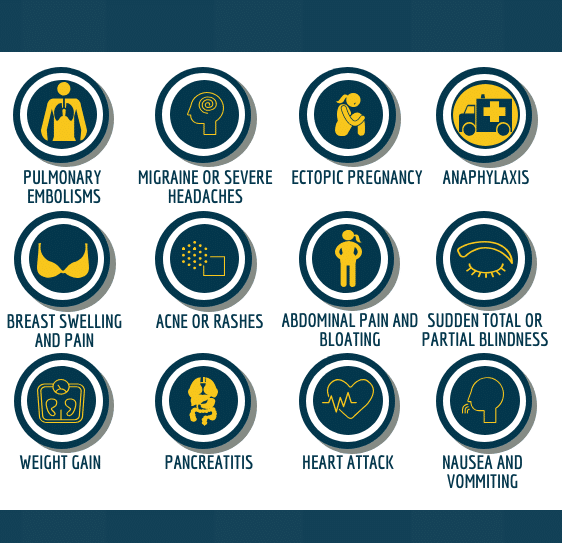An estimated 966 million women of reproductive age globally use some form of birth control. These methods of contraception include hormonal and non-hormonal birth control, both of which have devastating effects on both the health and the well-being of the family.
Hormonal birth control risks include a long list of side effects, such as ectopic pregnancies, cancers, heart attacks, mood swings, and depression. Hormonal birth control can even affect whom a woman is attracted to!
In addition, all contraception has horrible effects on marriage, as it requires that the spouses use each other rather than giving and receiving fully and selflessly. It has also been used by corrupt governments to control populations of target countries.
Birth control risks vary based on the type of birth control used. Let’s go through each of these effects in more detail.
Hormonal Birth Control Risks
How Does Hormonal Birth Control Work?
Hormonal birth control functions as both a contraceptive and an abortifacient. It uses either progesterone or a combination of progesterone and estrogen to prevent pregnancy by suppressing ovulation, or by thickening cervical mucus to prevent sperm from reaching the egg. In addition, hormonal birth control thins the uterine lining so that if conception occurs, the new human being cannot implant in the uterus and dies.
There are various types of hormonal birth control. It can be injected, taken orally, implanted under the skin, placed in the vagina or uterus, or used as a patch on the skin.
Hormonal methods of birth control include:
- Birth control pills
- Implants such as Norplant, Jadelle, and Implanon
- Injectables such as Depo-Provera and Lunelle
- Most intrauterine devices (IUDs)
- Patches and rings
- Abortion pills and so-called emergency “contraception,” including Cytotec, ellaOne, Mifegyne, Mifeprix, Plan B and Misoprostol.
All of these contain either one or a combination of artificial progestins and artificial estrogens.1
Side Effects Overview
Though feminist groups and the mainstream media typically present birth control as a boon for women, they overlook the serious side effects reported in mainstream scientific literature, either through deliberate intent or negligence. Women who regularly ingest the powerful steroids in all modern hormonal methods of birth control will find that they usually suffer a wide range of side effects.

This should come as no surprise since hormonal birth control methods such as the pill are listed as carcinogens (causes of cancer) by their own manufacturers.2
The potential birth control risks for women’s health are plentiful and worrisome. The patient information pamphlets for hormonal birth control methods list a long range of side effects, including3:
- Heart attacks
- Cancers
- Anaphylaxis
- Sudden total or partial blindness
- Pulmonary embolisms
- Early unintended abortion
- High blood pressure
- Dizziness and fainting
- Abdominal discomfort, bloating, and pain
- Gall bladder problems, including gallstones
- Inflammation of the pancreas
- Nausea and vomiting
- Fluid accumulation
- Long-term hormonal regulation problems
- Ectopic pregnancies
- Insulin sensitivity
- Elevated potassium levels
- Migraines or severe headaches
- Depression and mood swings
- Breast pain and swelling
- Changes in menstruation patterns, e.g., PMS and dysmenorrhea
- Acne
- Rashes
- Stroke
- Hair loss
- Loss of libido
- Fatigue
- Significant weight gain
- Fatal blood clots
Deep Vein Thrombosis
One of the most serious negative effects that women on hormonal birth control may face is the increased risk of deep vein thrombosis, or blood clots that can be fatal.
According to the Journal of Pharmacology and Pharmaco-therapeutics, some versions of the pill increase the risk of deep vein thrombosis up to eight times.4
Sexual Dysfunction
Among the other various negative effects of the hormonal methods is difficulty regulating a woman’s testosterone levels, even when she no longer uses the method. Researchers have found that abnormally low amounts of unbound testosterone caused by the use of the pill (or other methods of hormonal birth control) persist after women cease using it.
Women’s bodies use testosterone, as men’s do, to regulate sexual function, though in far lower amounts. Report coauthor Dr. Irwin Goldstein clarified: “This work is the culmination of 7 years of observational research in which we noted in our practice many women with sexual dysfunction who had used the oral contraceptive but whose sexual and hormonal problems persisted despite stopping the birth control pill.”5
Cancer
The hormonal methods of birth control increase the risk of cancer in women of childbearing age.

When taking hormonal contraceptives, “teenagers are especially vulnerable to breast cancer risk because their breasts are growing,” reports the Breast Cancer Prevention Institute. The Institute also says that although the pill lowers the risk of ovarian and endometrial cancers, “according to the American Cancer Society, out of [a random selection of] 100 women with cancer, 31 have breast cancer, 6 have endometrial cancer and only 3 have ovarian cancer, so it is not a good ‘trade-off’ in risk.”
The National Cancer Institute confirms this view by stating, “Studies have provided consistent evidence that the risks of breast and cervical cancers are increased in women who use oral contraceptives, whereas the risks of endometrial, ovarian, and colorectal cancers are reduced.”6
Depression and Other Psychological Effects
Elizabeth Lee Vliet, MD, a women’s health specialist and the author of It’s My Ovaries, Stupid!, has studied the birth control pill’s negative impacts on women’s moods, with a particular emphasis on high-progesterone formulations. She found that they “might even bring about the need for antidepressants: The Pill screws up a woman’s mood and libido, and then she ends up on Prozac.”7
Dr. Vliet’s opinion is reinforced by the manufacturers of the hormonal methods themselves. Their patient information pamphlets list depression and nervousness as psychiatric disorders caused by their methods.8
Influencing Partner Attraction
Hormonal birth control directly influences the hormonal cycle in women, but its impacts go far beyond mood swings. One of the most interesting studies done on hormonal birth control risks found that women on these drugs may be influenced to begin a relationship with the wrong men.
A study published in the August 2008 edition of the Proceedings of the Royal Society B found that when women smelled the T-shirts worn by men, they were attracted to more genetically dissimilar men before going on the Pill, and more genetically similar men after going on it.

As evolutionary psychologist Craig Roberts, one of the researchers, explains, “Not only could [genetic] similarity in couples lead to fertility problems but it could ultimately lead to the breakdown of relationships when women stop using the contraceptive pill, as odor perception plays a significant role in maintaining attraction to partners.”9
This fascinating study has thus found that birth control risks are not just physical, but social as well, and may subtly influence a woman into being attracted to “Mr. Wrong.”
Environmental Poisoning
Much of the female hormonal content in these contraception methods is excreted via urine and ends up in rivers and lakes. Scientists are finding ever-greater numbers of “intersex” animals in aquatic environments that could lead to a collapse in fish and other populations, followed by a collapse in the populations of animals dependent upon them.
In 2004, The Washington Post reported that 79% of the male smallmouth bass in the Potomac River are growing eggs.10 In certain places, said the Post, “100% of the male fish had some female characteristics.”
A later Washington Post article described how scientists said the cause “is probably some pollutant created by humans — perhaps a farm chemical, or treated sewage, which can contain human hormones or residue from birth-control pills.” The later Post article reported that scientists think the problem is caused by a mixture of hormone and hormone-mimicking pollutants and have found negative effects on female fish as well.11
Iain Murray, author of The Really Inconvenient Truths, wrote on National Review Online, “By any standard typically used by environmentalists, the pill is a pollutant. It does the same thing, just worse, as other chemicals they call pollution.”
Early Abortion
Though hormonal contraceptives appear to act the great majority of the time to prevent conception by suppressing ovulation and inhibiting sperm transport through the woman’s body, at other times they cause abortion by preventing or disrupting the implantation of an already-conceived child.
In some women, hormonal birth control suppresses ovulation completely. But if the method fails and conception and implantation occur, the user may feel that because she intended not to have a child, and because “technology failed her,” she is entitled to a surgical or medical abortion.
A Special Look at Intrauterine Devices (IUDs)
IUDs carry significant risk. Not only are they abortifacients (as they prevent implantation, thereby causing early abortion), but they also carry the risk of hemorrhage, perforation of the uterus or other organs, pelvic inflammatory disease, deep embedding of the IUD, or inflammation of the fallopian tubes (salpingitis), among other side effects–especially if they are hormonal IUDs. If a woman with an IUD becomes pregnant, the lives of both the mother and baby are at risk.
Non-Hormonal Birth Control Risks
Two of the most common non-hormonal birth control methods are condoms and copper IUDs.
Copper IUDs
Copper IUDs carry many of the same risks as hormonal IUDs, including perforation, deep embedding, and death of both mother and baby if pregnancy occurs.
Condoms
While many assume that condoms provide the “protection” they’re seeking, after using just 10 condoms, the likelihood that at least one of them fails is a staggering 46.5%! And “perfect” condom usage is unlikely in the real world given that condoms require great attention to detail. This lack of “perfect” condom usage increases chances of condom failure.
13% of couples who use condoms get pregnant each year. This percentage only compounds over time. After 5 years, the likelihood grows to 50%.
Likelihood of Pregnancy after Years of Condom Usage
Source: https://www.hli.org/resources/how-effective-are-condoms/
Further, condoms do not adequately protect against sexually transmitted diseases or sexually transmitted infections. Specifically, condoms cannot protect against infections that are transmitted through skin-to-skin contact or that affect areas not covered by the condom. Examples of such infections include HPV, herpes, and syphilis (the CDC admits that condoms do not protect against these diseases). Given that incorrect use of condoms is common, HIV transmission risk is also high. Indeed, there is only an 80-94% reduction in transmission risk, and thus there is a 6-20% chance of transmitting HIV. This risk of HIV transmission only compounds with each use.
Social Effects of Birth Control
Impacts on Marriage
Contraception also hurts marriages. Studies show that the use of artificial birth control drastically increases divorce rates.
The conjugal act has two ends: procreation and unity of the spouses. Each marital embrace must be open to life–otherwise, the procreative nature of the act is frustrated, and the act itself becomes disordered. Because contraception prevents a couple from being open to life, it disrupts the conjugal act on a physical and spiritual level, and it violates the Catholic marriage vow to be open to life. Every offense against the marriage vows damages the marriage itself.
When a couple is not open to life, the conjugal act, which was created to be self-giving, becomes selfish. Both parties are then using the other for their own pleasure rather than acting in a self-sacrificial manner and accepting responsibility. In using contraception, a couple is rejecting the other’s fertility and acting in a way that “protects” them from the other. They can neither give themselves fully nor receive their spouse fully.
This is not to say that couples must have as many children as physically possible. Indeed, a critical part of responsible parenthood is ensuring that the parents can care for and raise a child. In serious circumstances, a couple may choose to practice natural family planning (NFP), which can effectively delay pregnancy without eliminating the procreative end of the conjugal act.
Population Control
Pope Paul VI predicted that forced sterilization would result from widespread acceptance of contraception. Tragically, this came true. Government organizations have forced contraception on both men and women for population control.
NSSM-200 (or The Kissinger Report) is the declassified US foreign policy as it relates to 13 target countries (India, Brazil, Bangladesh, the Philippines, Thailand, Egypt, Turkey, Ethiopia, Colombia, Pakistan, Nigeria, Mexico, and Indonesia). This document outlines the US’ plan to use incentives for countries to increase abortion rates and incentives to convince residents of these countries (particularly the impoverished) to be sterilized or use contraceptives. In cases where these and other developing nations refused to legalize abortion or increase contraceptive use, the US withdrew support and aid from that country.
IUDs have also been placed in Inuit women without consent in Greenland, allegedly to decrease the Inuit population. The story is similar in India, which sterilized 6.2 million men in the ’70s (and thousands died as a result of botched sterilizations). Again, we see the same in Peru in the ’90s, when President Fujimori practically forced women to sterilize themselves, offering poor women food as a cruel incentive. Perhaps the most famous example of forced sterilization and abortion is China’s one-child policy, which led to more than 330 million abortions, millions of sterilizations, and severe population decline. Sadly, these are only a few examples of government-imposed population control, which results from a nation straying far from truth.
Conclusion
Birth control risks range from headaches and hair loss to fatal diseases such as cancer and deep-vein thrombosis. The impact of contraception extends to society in general through environmental pollution and the psychological problems that contraception users suffer. In summary, contraception not only harms women, it harms the rest of us as well.
+ Endnotes
[1] The chemicals used in hormonal methods of birth control commonly include one of about a dozen different artificial progestins — cyproterone acetate, dienogest, desogestrel, drospirenone, ethynodiol diacetate, etonogestrel, gestodene, levonorgestrel, medroxyprogesterone acetate (DMPA), norelgestromin, norethindrone, norethindrone acetate and norgestrel. All of the methods (except for the progestin-only minipill and some other methods such as IUDs, implants and abortion pills) also include the artificial estrogens ethinyl estradiol or estradiol cypionate. See the patient information pamphlets for each method to determine the exact combination of hormones they contain.
[2] Review of 1,346 patient information pamphlets on various hormonal methods of birth control distributed by the manufacturers. The National Cancer Institute (NIC) states, “The risks of breast and cervical cancers are increased in women who use oral contraceptives, whereas the risks of endometrial, ovarian, and colorectal cancers are reduced.”
[3] This example is Janssen Pharmaceuticals, “Micronor®” Oral Contraceptive Tablets, May 2020. Bayer HealthCare Pharmaceuticals, “Highlights of Prescribing Information: Yasmin,” April 2012.
To see the patient information pamphlet for any hormonal birth control method, visit the National Institute for Health’s DailyMed website.
[4] Kiran G. Piparva and Jatin G. Buch. “Deep Vein Thrombosis in a Woman Taking Oral Combined Contraceptive Pills.” Journal of Pharmacology and Pharmacotherapeutics, Volume 2, Number 3 [July-September 2011], pages 185 and 186.
[5] Claudia Panzer, M.D., et.al. “Impact of Oral Contraceptives on Sex Hormone‐Binding Globulin and Androgen Levels: A Retrospective Study in Women with Sexual Dysfunction.” The Journal of Sexual Medicine, Volume 3, Issue 1 [January 1, 2006], pages 104 to 113.
[6] National Cancer Institute. “Oral Contraceptives and Cancer Risk.” February 22, 2018. It should be noted that the National Cancer Institute also says that breast cancers and cervical cancers are much more common than endometrial, ovarian, and colorectal cancers.
[7] Rachael Combe, M.D. “Sexual Chemistry.” Elle, September 2005.
[8] Janssen Pharmaceuticals, “Micronor®” Oral Contraceptive Tablets, May 2020.
[9] University of Liverpool. “Contraceptive Pill Influences Partner Choice.” ScienceDaily, August 13, 2008.
[10] David A. Fahrenthold. “Male Bass in Potomac Producing Eggs.” The Washington Post, October 15, 2004.
[11] David A. Fahrenthold. “‘Human Activity’ Blamed for Fish Ills.” The Washington Post, February 8, 2008, page B03.







Informative article, but one thing it didn’t make clear is that using hormonal birth control disrupts a woman’s menstrual cycle by suppressing ovulation. The “period” she has every month isn’t natural but basically fake – so she doesn’t get the many health benefits of natural ovulation.
Many women are realizing that hormonal birth control is bad for their bodies and minds, and are starting to practice fertility awareness methods that work with, rather than against, the natural processes of their bodies. Many of them are also educating their doctors on the subject – another good effect!
Please see a site called Natural Womanhood (which is affiliated with the Couple to Couple League) for more information.
I can testify that sterilization is harmful to a marriage. My ex-husband had a vasectomy, which I was okay with me. I lost interest in having intimate relations with him after that. I was raised in a Protestant home and didn’t understand what I do now, thanks to conservative Catholics who are still standing up for truth and educating those of us who will listen.